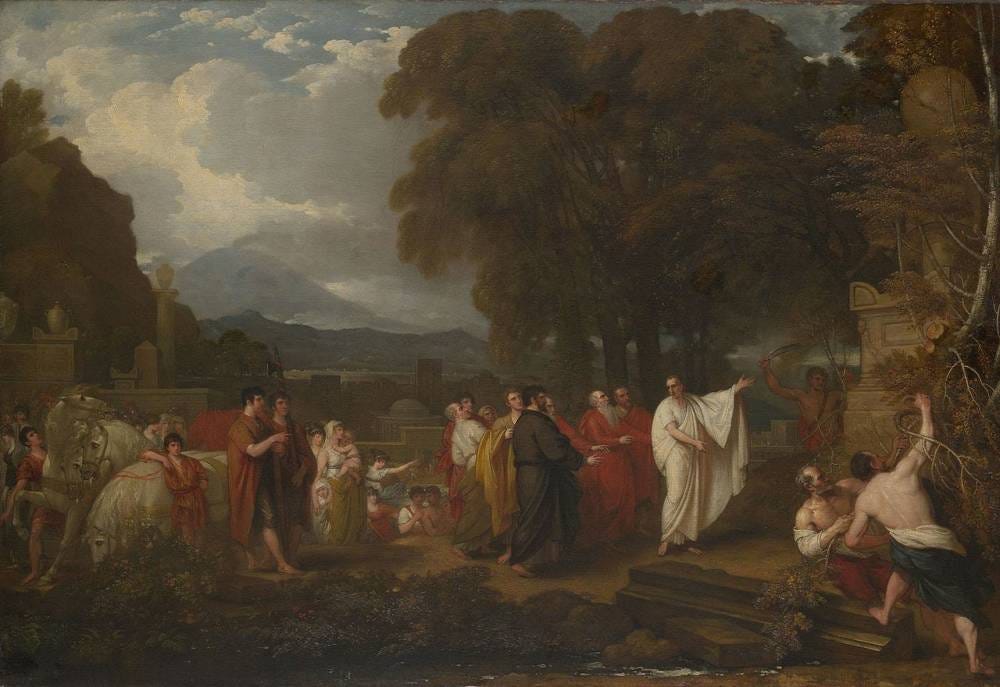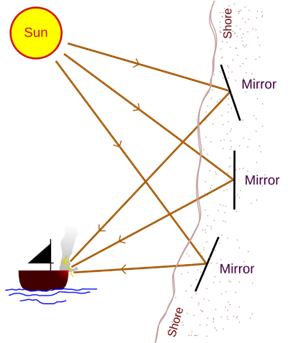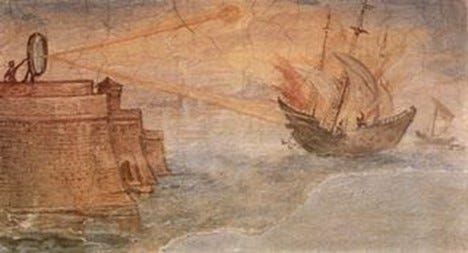By David GosselinIn “Archimedes and the Student,” Friedrich Schiller offers a cautious reminder to all those living through times in which “Utility is the great idol of the age, to which all powers are supposed to be a slave and to which all talents are to pay homage.” For in these times, Schiller says, “The spiritual merit of art has no weight in this crude balance, and deprived of all encouragement, it disappears from the noisy market of the century.” While artists and scientists will always have to recognize and contend with the forces of utility, they need never worship it, or pay it homage, and they must ultimately serve as the creative bulwark against all such idol worship. If artists and scientists are forced to worship utility and its many needy sisters, whether under the rule of some twenty-first century dystopian Technate[1] and its technocratic prelates or at the altar of “efficiency” and Scientism, the fruits of true science and art are bound to rot on the vine, if said vines even remain fruitful, or aren’t altogether uprooted in favor of simulated flavors. Thus, in his second letter on aesthetic education Schiller describes the function of ideal art, as opposed to those forms of artistic expression which ultimately operate under “the pressing need of matter.” Rather than bow down under the “tyrannical yoke” of utility, ideal art is neither its hostage nor its pupil, but a guide and teacher for the age, to draw its pupils upwards, rather then downwards in the worship of idols. Schiller identified how ideal art’s borders found themselves narrowed by the utilitarian concerns of his age, including by those interested in reaping the fruits of modern science and technological progress. In this way, he revisits his theme from a scientific perspective, in the person of Archimedes of Syracuse. Thus, “Archimedes and the Student” is a poem about ideal science. Archimedes was the last great living representative of the Classical Greek scientific tradition, until he was murdered by a Roman soldier during Rome’s siege of Syracuse in 212 0r 211 BCE. The murder of the great mathematician and inventor symbolized the death of the great Classical Greek scientific tradition stretching back to its early Ionian origins. While Rome would make use of many innovations and engineering feats to expand its empire later on, the spirit of pure science embodied by the likes of an Archimedes or Archytas had passed. It would not be until the time of the Italian Golden Renaissance that we would see this same creative spirit flourish with renewed fire, as we’ll see in our upcoming “Secrets of the Renaissance” series. Notably, Archimedes was famous for his many mechanical innovations and visionary trinkets. However, the sagely architect was reputed to have only viewed his mechanical designs as the worldly incarnations of a more divine source. Rather than echoing the crude mechanistic view of science as some kind of precise art aimed at generating immediate practical gains for oneself, the state, or business enterprise, Schiller adopts the Classical Greek spirit of science as typified by Archimedes the mathematician-architect-inventor. In him Schiller saw a sage whose inquiries and discoveries he never felt compelled to make under the threat of chains or demands of the world, but rather for the love of knowledge and desire to acquaint himself with the beauty of the kosmos itself. That higher love, in truth, is what made his many intricate designs possible in the first place. Schiller’s poem reads as follows: Archimedes and the Student An inquisitive youth once met Archimedes the sage, Translation © David B. Gosselin Original. Zu Archimedes kam ein wißbegieriger Jüngling, Schiller’s poem offers an insightful and biting variation on a theme echoed throughout many of his thought-poems, namely, the importance of approaching art, science and all higher domains of knowledge with a quasi-religious reverence, rather than for merely self-seeking or purely worldly i.e mortal aims. Rather than seeking to narrow and reduce one’s notions to make them more amenable to easy human understanding, we should be willing to expand and elevate our own conceptual powers, thereby allowing ourselves to become vehicles for ideals that aren’t merely earth-bound, but transcendent and immortal. As Frances Yates notes in her book, Giordano Bruno and the Hermetic Tradition, which takes an interest in the rediscovery of Greek science in the Renaissance:
Schiller makes similar observations in his fifteenth letter on the aesthetic education of man. There, he discusses the notion of divine play in respect to science as that state in which man finds himself when freedom and necessity, Beauty and Truth, are seamlessly wed:
In terms of science proper, the many “quantitative” arts derived from scientific inquiry provide myriad quantifiable benefits to a state and its citizens, but a genuine appreciation for the true drama that is the history of science reminds us that these “quantitative methods,” which would be elaborated and refined in the post-Renaissance world, were but the fruit of a sacred art which depended on the “qualitative” aspects of hypothesis-formation, imagination and creativity itself—which only freely emerge in play. So Schiller says, man “is only wholly man, where he plays.” Schiller’s corpus is replete with notable warnings against trying to approach subjects of a divine nature with a baser mechanical spirit or childish (as opposed to playful) self-interest, as most of the world is inclined to do. In “The Veiled Image at Sais,” Schiller reminds us:
In the case of “The Veiled Image of Sais,” the subject is divine Truth itself, and the sorts of unimagined troubles encountered by one who too eagerly seeks to breach its mysterious gates, a theme which also re-emerges in Schiller’s remarkable short story, “The Ghost Seer.” In the case of “Archimedes and the Student,” the divine subject is science, personified by Archimedes, the last of the great Classical Greek scientific minds. Returning to Archimedes’ student, we can observe that while our inquisitive young friend may be under the impression that if he can successfully woo the goddess and play his cards right, he can get something out of it—some benefit. But whilst science may often be abstracted in the feminine, our sage playfully chides the boy, “seek not the woman in her.” (suche in ihr nicht das Weib). To the degree he thinks he can approach his subject in some mortal manner, or that this goddess behaves in ways familiar to the mortal world, the student will be surprised and dumbfounded, and likely only grow bitter as the goddess remains unyielding to his charms withholds her own. After all, the muses of science are not much different than the muses of art, as any sound creative mind knows. As Schiller writes in his poem “The Singer’s Farewell”:
And here, one is forced to reckon with the idea that one’s conceptual powers, that is, one’s creativity, are inextricably wound up in his moral and spiritual constitution. Those positivism-addled minds which insist on science being reduced to nothing but purely quantitative considerations inevitably blind themselves to the higher reality which allows the fruits of discovery to blossom. Thus, by distinguishing the worldly benefits of science from the “divine art” which engenders them, Schiller brings attention to the subjective state of mind which the scientist must be willing to ascend to if he wishes to truly serve this “goddess,” rather than simply pay homage to idols, or himself. [1] The region over which a technocratic society would operate using thermodynamic energy accounting instead of a price system (money) method. David Gosselin is a poet, researcher, and translator in Montreal, Canada. He is the founding editor of The Chained Muse. His personal Substack is Age of Muses, where he publishes historical deep-dives, original poetry and a variety of writings for a new renaissance. The Rising Tide Foundation is a non-profit organization based in Montreal, Canada, focused on facilitating greater bridges between east and west while also providing a service that includes geopolitical analysis, research in the arts, philosophy, sciences and history. Consider supporting our work by subscribing to our substack page. Also watch for free our RTF Docu-Series “Escaping Calypso’s Island: A Journey Out of Our Green Delusion.” You're currently a free subscriber to Rising Tide Foundation. For the full experience, upgrade your subscription. |
Thursday, 8 May 2025
Reflections on Ideal Science and Art: Schiller’s “Archimedes and the Student”
Subscribe to:
Post Comments (Atom)
Sunday Event #2: Trotsky and the Neoconservatives: Lets Talk About the Trajectory of Liberalism at 2pm ET
Speaker: Caleb Maupin ͏ ͏ ͏ ͏ ͏ ͏ ͏ ͏ ͏ ͏ ͏ ͏ ͏ ͏ ͏ ͏ ͏ ...
-
APO posted: "Le Togo organisera en avril prochain, une "Conférence de haut niveau sur les transitions politiques et la...





No comments:
Post a Comment